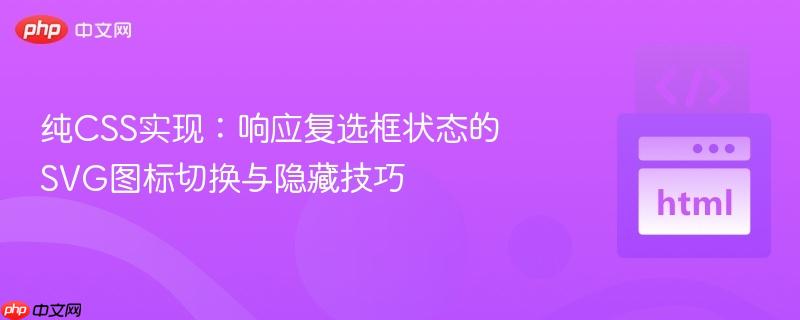
本文详细介绍了如何利用纯css,通过复选框(checkbox)的状态变化来动态切换和隐藏svg图标,从而构建一个交互式的主题切换器。核心技巧在于巧妙运用css的`visibility`属性与相邻兄弟选择器,实现图标的平滑显示与隐藏,避免了javascript的介入,保持了css的强大控制力。
在现代Web开发中,实现交互式UI组件往往需要JavaScript的辅助。然而,对于一些状态切换类的组件,例如主题切换器(深色/浅色模式),纯CSS也能提供优雅且高性能的解决方案。本文将深入探讨如何利用HTML的复选框(input type="checkbox")结合CSS的强大选择器和属性,实现一个带有动态SVG图标切换效果的纯CSS开关。我们将重点解决在复选框不同状态下,如何精确控制两个SVG图标(例如太阳和月亮)的显示与隐藏。
在尝试根据复选框状态切换元素显示时,开发者常会想到使用display: none;来隐藏元素。然而,display: none;会使元素完全从文档流中移除,不占据任何空间,这在某些需要保持布局稳定或进行过渡动画的场景下可能不适用。例如,当两个图标需要交换位置或平滑切换时,display: none;会导致瞬间的布局跳动。
为了解决这个问题,CSS提供了visibility属性。当设置为visibility: hidden;时,元素虽然不可见,但它仍然占据着其在文档流中的原始空间。这使得我们可以在不影响周围布局的前提下,通过切换visibility: visible;来显示元素。更重要的是,visibility属性可以进行过渡动画,虽然不像opacity那样平滑,但在某些场景下仍然非常有用。
为了实现纯CSS的开关效果,HTML结构至关重要。我们需要一个label元素来包裹input[type="checkbox"],这样点击整个开关区域都能触发复选框状态的改变,提升用户体验。在label内部,除了隐藏的复选框,还需要一个容器来承载开关的视觉部分,以及两个分别代表不同状态的SVG图标。
立即学习“前端免费学习笔记(深入)”;
以下是实现此功能所需的HTML结构示例:
<label class="ThemeToggler" for="ThemeTogglerID">
<!-- 隐藏的复选框,用于控制状态 -->
<input id="ThemeTogglerID" class="ThemeTogglerInput" type="checkbox" checked />
<!-- 开关的视觉填充区域和图标容器 -->
<div class="ThemeTogglerFill">
<!-- 太阳图标 -->
<div class="SunIcon">
<svg xmlns="http://www.w3.org/2000/svg" viewBox="0 0 24 24">
<!-- 太阳SVG路径 -->
<path d="M12,18c-3.3,0-6-2.7-6-6s2.7-6,6-6s6,2.7,6,6S15.3,18,12,18zM12,8c-2.2,0-4,1.8-4,4c0,2.2,1.8,4,4,4c2.2,0,4-1.8,4-4C16,9.8,14.2,8,12,8z" />
<path d="M12,4c-0.6,0-1-0.4-1-1V1c0-0.6,0.4-1,1-1s1,0.4,1,1v2C13,3.6,12.6,4,12,4z" />
<path d="M12,24c-0.6,0-1-0.4-1-1v-2c0-0.6,0.4-1,1-1s1,0.4,1,1v2C13,23.6,12.6,24,12,24z" />
<path d="M5.6,6.6c-0.3,0-0.5-0.1-0.7-0.3L3.5,4.9c-0.4-0.4-0.4-1,0-1.4s1-0.4,1.4,0l1.4,1.4c0.4,0.4,0.4,1,0,1.4C6.2,6.5,5.9,6.6,5.6,6.6z" />
<path d="M19.8,20.8c-0.3,0-0.5-0.1-0.7-0.3l-1.4-1.4c-0.4-0.4-0.4-1,0-1.4s1-0.4,1.4,0l1.4,1.4c0.4,0.4,0.4,1,0,1.4C20.3,20.7,20,20.8,19.8,20.8z" />
<path d="M3,13H1c-0.6,0-1-0.4-1-1s0.4-1,1-1h2c0.6,0,1,0.4,1,1S3.6,13,3,13z" />
<path d="M23,13h-2c-0.6,0-1-0.4-1-1s0.4-1,1-1h2c0.6,0,1,0.4,1,1S23.6,13,23,13z" />
<path d="M4.2,20.8c-0.3,0-0.5-0.1-0.7-0.3c-0.4-0.4-0.4-1,0-1.4l1.4-1.4c0.4-0.4,1-0.4,1.4,0s0.4,1,0,1.4l-1.4,1.4C4.7,20.7,4.5,20.8,4.2,20.8z" />
<path d="M18.4,6.6c-0.3,0-0.5-0.1-0.7-0.3c-0.4-0.4-0.4-1,0-1.4l1.4-1.4c0.4-0.4,1-0.4,1.4,0s0.4,1,0,1.4l-1.4,1.4C18.9,6.5,18.6,6.6,18.4,6.6z" />
</svg>
</div>
<!-- 月亮图标 -->
<div class="MoonIcon">
<svg xmlns="http://www.w3.org/2000/svg" viewBox="0 0 24 24">
<!-- 月亮SVG路径 -->
<path d="M12.1,22c-0.3,0-0.6,0-0.9,0c-5.5-0.5-9.5-5.4-9-10.9c0.4-4.8,4.2-8.6,9-9c0.4,0,0.8,0.2,1,0.5c0.2,0.3,0.2,0.8-0.1,1.1c-2,2.7-1.4,6.4,1.3,8.4c2.1,1.6,5,1.6,7.1,0c0.3-0.2,0.7-0.3,1.1-0.1c0.3,0.2,0.5,0.6,0.5,1c-0.2,2.7-1.5,5.1-3.6,6.8C16.6,21.2,14.4,22,12.1,22zM9.3,4.4c-2.9,1-5,3.6-5.2,6.8c-0.4,4.4,2.8,8.3,7.2,8.7c2.1,0.2,4.2-0.4,5.8-1.8c1.1-0.9,1.9-2.1,2.4-3.4c-2.5,0.9-5.3,0.5-7.5-1.1C9.2,11.4,8.1,7.7,9.3,4.4z" />
</svg>
</div>
</div>
</label>我们将使用SCSS来编写样式,因为它提供了变量、混合(mixin)和嵌套等功能,使得代码更易于维护和阅读。
首先定义一些SCSS变量,用于控制开关的尺寸、颜色等,方便统一管理。
$width: 80px;
$height: 44px;
$border-radius: 50px;
$circle-size: $height - 4px; // 滑块大小
$icon-size: $circle-size - 2px; // 图标大小
// 颜色变量
$neutral: red;
$secondary: white;
$base-100: white;
$base-200: gray;
$base-300: black;
$base-content: white;
// 开关容器样式
.ThemeToggler {
width: $width;
height: $height;
flex-shrink: 0;
border-radius: $border-radius;
background-color: $neutral;
border: 1px solid $base-100;
display: inline-block;
cursor: pointer;
&:hover {
border-color: $secondary;
}
}.ThemeTogglerFill 是开关的背景和滑块的容器。滑块本身通过伪元素 ::before 实现,并带有过渡效果。
.ThemeTogglerFill {
position: relative; // 伪元素定位的参考
&:before {
content: "";
position: absolute;
top: 1px;
left: 1px;
height: $circle-size;
width: $circle-size;
background: $base-300;
box-shadow: 1px 0px 4px rgba(0, 0, 0, 0.15);
border-radius: $border-radius;
transition: background-color 0.25s, transform 0.25s; // 添加过渡动画
}
}input.ThemeTogglerInput 是实现状态切换的核心,但它本身应该被隐藏。通过&:checked伪类和通用兄弟选择器~,我们可以根据复选框的选中状态来控制其兄弟元素(.ThemeTogglerFill)的样式,从而实现滑块的移动。
.ThemeTogglerInput {
display: none; // 隐藏原生复选框
// 当复选框被选中时,移动滑块
&:checked ~ .ThemeTogglerFill::before {
transform: translateX($circle-size); // 滑块向右移动一个其自身宽度
}
// ... 接下来的图标切换逻辑
}这是本教程的关键部分。我们将利用相邻兄弟选择器+和visibility属性来控制图标的显示与隐藏。
首先,定义一个@mixin来统一图标的通用样式。
@mixin icon {
position: relative; // 方便图标内部SVG的定位
display: block;
width: $icon-size;
height: $icon-size;
border-radius: 50%;
overflow: hidden; // 确保SVG内容不会溢出
fill: $base-content; // 设置SVG的填充色
}
.SunIcon {
@include icon;
top: 1.8px;
left: 1.7px;
}
.MoonIcon {
@include icon;
top: -35px; // 初始定位,可能需要调整以确保图标在正确位置
left: $circle-size + 2px;
}现在,我们将图标的visibility逻辑集成到.ThemeTogglerInput的样式中:
.ThemeTogglerInput {
display: none;
&:checked ~ .ThemeTogglerFill::before {
transform: translateX($circle-size);
}
// 默认状态(复选框未选中)
// 使用 '+' 相邻兄弟选择器,因为 .ThemeTogglerFill 紧跟在 .ThemeTogglerInput 后面
& + .ThemeTogglerFill {
.MoonIcon {
visibility: hidden; // 月亮图标默认隐藏
}
.SunIcon {
visibility: visible; // 太阳图标默认显示
}
}
// 选中状态(复选框被选中)
&:checked + .ThemeTogglerFill {
.SunIcon {
visibility: hidden; // 太阳图标隐藏
}
.MoonIcon {
visibility: visible; // 月亮图标显示
}
}
}通过上述SCSS代码,我们实现了:
完整的SCSS代码如下:
$width: 80px;
$height: 44px;
$border-radius: 50px;
$circle-size: $height - 4px;
$icon-size: $circle-size - 2px;
$neutral: red;
$secondary: white;
$base-100: white;
$base-200: gray;
$base-300: black;
$base-content: white;
.ThemeToggler {
width: $width;
height: $height;
flex-shrink: 0;
border-radius: $border-radius;
background-color: $neutral;
border: 1px solid $base-100;
display: inline-block;
cursor: pointer;
&:hover {
border-color: $secondary;
}
}
.ThemeTogglerFill {
position: relative;
&:before {
content: "";
position: absolute;
top: 1px;
left: 1px;
height: $circle-size;
width: $circle-size;
background: $base-300;
box-shadow: 1px 0px 4px rgba(0, 0, 0, 0.15);
border-radius: $border-radius;
transition: background-color 0.25s, transform 0.25s;
}
}
.ThemeTogglerInput {
display: none;
&:checked ~ .ThemeTogglerFill::before {
transform: translateX($circle-size);
}
// 默认状态:复选框未选中时,显示太阳,隐藏月亮
& + .ThemeTogglerFill{
.MoonIcon{
visibility:hidden;
}
.SunIcon {
visibility: visible;
}
}
// 选中状态:复选框选中时,隐藏太阳,显示月亮
&:checked + .ThemeTogglerFill {
.SunIcon {
visibility: hidden;
}
.MoonIcon{
visibility:visible;
}
}
}
@mixin icon {
position: relative;
display: block;
width: $icon-size;
height: $icon-size;
border-radius: 50%;
overflow: hidden;
fill: $base-content;
}
.SunIcon {
@include icon;
top: 1.8px;
left: 1.7px;
}
.MoonIcon {
@include icon;
top: -35px; // 注意:此处的负值top可能是为了将月亮图标定位到正确位置,具体值需根据实际布局调整
left: $circle-size + 2px;
}visibility vs display:
CSS选择器优先级和结构:
以上就是纯CSS实现:响应复选框状态的SVG图标切换与隐藏技巧的详细内容,更多请关注php中文网其它相关文章!

每个人都需要一台速度更快、更稳定的 PC。随着时间的推移,垃圾文件、旧注册表数据和不必要的后台进程会占用资源并降低性能。幸运的是,许多工具可以让 Windows 保持平稳运行。

Copyright 2014-2025 https://www.php.cn/ All Rights Reserved | php.cn | 湘ICP备2023035733号